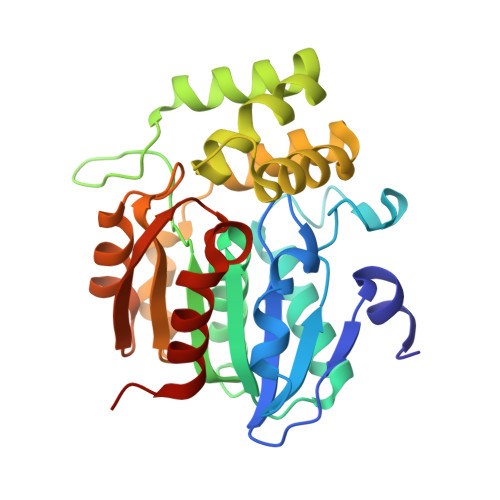Structural insights into rice KAI2 receptor provide functional implications for perception and signal transduction.
Guercio, A.M., Gilio, A.K., Pawlak, J., Shabek, N.(2024) J Biol Chem 300: 107593-107593
- PubMed: 39032651
- DOI: https://doi.org/10.1016/j.jbc.2024.107593
- Primary Citation of Related Structures:
8VCZ, 8VD1, 8VD3 - PubMed Abstract:
KAI2 receptors, classified as plant α/β hydrolase enzymes, are capable of perceiving smoke-derived butenolide signals and endogenous, yet unidentified KAI2-ligands (KLs). While the number of functional KAI2 receptors varies among land plant species, rice has only one KAI2 gene. Rice, a significant crop and representative of grasses, relies on KAI2-mediated Arbuscular mycorrhiza (AM) symbioses to flourish in traditionally arid and nutrient-poor environments. This study presents the first crystal structure of an active rice (Oryza sativa, Os) KAI2 hydrolase receptor. Our structural and biochemical analyses uncover grass-unique pocket residues influencing ligand sensitivity and hydrolytic activity. Through structure-guided analysis, we identify a specific residue whose mutation enables the increase or decrease of ligand perception, catalytic activity, and signal transduction. Furthermore, we investigate OsKAI2-mediated signaling by examining its ability to form a complex with its binding partner, the F-box protein DWARF3 (D3) ubiquitin ligase and subsequent degradation of the target substrate OsSMAX1, demonstrating the significant role of hydrophobic interactions in the OsKAI2-D3 interface. This study provides new insights into the diverse and pivotal roles of the OsKAI2 signaling pathway in the plant kingdom, particularly in grasses.
Organizational Affiliation:
Department of Plant Biology, The College of Biological Sciences, University of California - Davis, Davis, CA 95616.















